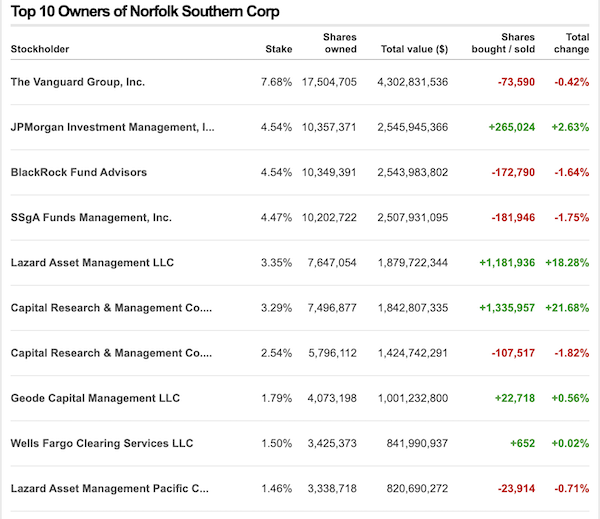NC | In this post, I will not cover what has been well-covered elsewhere: The derailment itself (50 cars, 20 of which carried toxic materials, 14 of those vinyl chloride), the subsquent fire, which burned for three days, the ultimate “controlled release” of the poisonous gas, the toxicity of vinyl chloride, the effects of the poison on locals, their pets, and their streams, or the arrest of the reporter who asked questions at Governor DeWine‘s presser. On the bright side, Norfolk Southern donated $25,000 to community shelters. NS is also funding a hotline to a toxicologist at an environmental consulting firm. The EPA has a timeline.
Rather, I shall begin from the very concrete (“for want of a nail…”) and move to the very abstract: From the wheel, to the truck, the cars, the firm (Norfolk Southern), and the owners.
Steel Wheels on Steel Rails
Steel wheels on steel rails inherently produce 85-99% less friction than rubber truck tires on roads; the contact point of a wheel to the rail is about the size of a dime. Hence the inherent advantage of rail over trucks for moving goods:
Compared to truck – its main competitor – train is cheaper (in the US it’s 4 cents vs 20 cents per ton-mile), more efficient (the record-breaking train was 682 cars and 4.5 miles long carrying 82,000 metric tons of ore), and more sustainable (one ton of freight can be moved over 470 miles on just a single gallon of diesel fuel).
However, if you want that advantage to be real and not just theoretical, you’ve got to maintain all that steel in good working order; after all, when things go wrong with a train that’s 4.5 miles long, they can go very, very wrong. Norfolk Southern adopted Precision Scheduled Railroading (see NC here, and alert reader Upstater, here) in 2019 (“average train speed increasing by 10%”), achieving a record operating ratio of 60.4% in 2022[3]. In so doing, it threw away the inherent advantage of rail. Specifically, in the East Palestine disaster, it did not maintain its steel wheels.
Due to NS intimidating (or corrupting) the regulators, train 32N was not classified as a “high-hazard flammable train,” despite its obviously hazardous and flammable cargo. Such a classification would have affected both its speed and its route (possibly not through East Palestine). From Lever News:
Though the company’s 150-car train in Ohio reportedly burst into 100-foot flames upon derailing — and was transporting materials that triggered a fireball when they were released and incinerated — it was not being regulated as a “high-hazard flammable train,” federal officials told The Lever.
Documents show that when current transportation safety rules were first created, a federal agency sided with industry lobbyists and limited regulations governing the transport of hazardous compounds. The decision effectively exempted many trains hauling dangerous materials — including the one in Ohio — from the “high-hazard” classification and its more stringent safety requirements.
I don’t have a documented connection to 32N’s classification and PSR, but it seems pretty obvious. Here from 49 CFR § 174.310 – “Requirements for the operation of high-hazard flammable trains”:
(2) Speed restrictions. All trains are limited to a maximum speed of 50 mph. The train is further limited to a maximum speed of 40 mph while that train travels within the limits of high-threat urban areas (HTUAs) as defined in § 1580.3 of this title, unless all tank cars containing a Class 3 flammable liquid meet or exceed the DOT Specification 117 standards, the DOT Specification 117P performance standards, or the DOT Specification 117R retrofit standards provided in part 179, subpart D of this subchapter.
No railroad company dedicated to increasing average train speed by 10% through PSR would ever want to comply with that statute (which also imposes restrictions on the routes to be followed and allowable cars).
Railroad Owners
Here are the owners of the NS:



0 comments:
Post a Comment